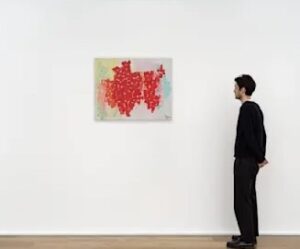Mathieu Questel is an enigmatic figure in the world of contemporary art, known for his evocative explorations of darkness, contrast, and depth. His concept of Blackout Beauty challenges traditional notions of aesthetics, using backdrop techniques, obscurity, and negative space to create deeply immersive visual experiences.
Through a masterful interplay of light and darkness, Questel’s work evokes a sense of mystery, intrigue, and emotion, drawing viewers into a world where the absence of light becomes its own form of expression.
The Philosophy Behind Blackout Beauty
Mathieu Questel’s artistic vision revolves around the idea that true beauty is not always found in clarity, color, or illumination, but in the void, the hidden, and the unseen. Blackout Beauty is an aesthetic that embraces the power of shadows—not as a mere absence of light, but as a force that defines form, emotion, and depth.
Questel’s work often draws inspiration from:
• Chiaroscuro – The Renaissance technique of using stark contrasts between light and dark to create volume and drama, famously utilized by artists like Caravaggio and Rembrandt.
• Minimalism and Negative Space – The idea that what is omitted or obscured can be just as important as what is revealed.
• Psychological Depth – The human mind is naturally drawn to mystery. Questel plays with this by leaving portions of his compositions undefined, allowing the viewer to project their own interpretations.
By exploring themes of obscurity, contrast, and absence, Questel challenges conventional perceptions of beauty, urging audiences to find allure in shadows and silence rather than overt brightness and detail.
Techniques and Mediums in Blackout Beauty
Mathieu Questel’s artistic approach is diverse, spanning multiple disciplines. His signature use of darkness is evident in the following methods:
The Use of Deep Blacks and Subtle Light
Questel’s work often employs ultra-dark pigments, including carbon blacks, Vantablack alternatives, and deep matte finishes that absorb nearly all light. These deep blacks create a sense of infinity and depth, making his compositions feel immersive and limitless.
Contrasting these dark elements, Questel introduces small bursts of light—soft gradients, fleeting highlights, or luminous details—to guide the eye and evoke emotion. The interplay between near-total darkness and delicate light forces the viewer to engage with the piece more deeply, searching for hidden meanings within the void.
Textured Black Surfaces and Multi-Layered Depth
Many of Questel’s paintings and sculptures feature highly textured black surfaces. By manipulating materials such as:
• Charcoal and Soot-Based Paints
• Roughened Canvas and Layered Paper
• Matte Acrylics Mixed with Fine Grit
Questel adds an almost sculptural quality to his darkness, making the shadows feel alive and dynamic.
Monochromatic Portraits and Figures Hidden in Darkness
One of Questel’s most striking artistic signatures is his ability to depict portraits that emerge from deep black backgrounds. These figures often feel like they are being swallowed by darkness, appearing ghostly or fleeting. This technique forces the viewer to confront ambiguity and transience, themes deeply rooted in existential philosophy and introspection.
“Eclipse of the Self” (2015)
One of Questel’s most discussed paintings, Eclipse of the Self, presents a near-black canvas where a barely discernible human face emerges from the shadows. The portrait is revealed only when light catches specific angles, giving the piece an interactive and almost haunting presence. The work questions self-identity, visibility, and perception, leaving the viewer in a constant state of search and discovery.
“Vanishing Form” (2018)
This sculptural installation utilizes highly absorbent black material to create the illusion of disappearing objects. Placed in a dimly lit gallery, the forms appear to shift and dissolve, making the audience question the boundaries of physical space and void.
“Obsidian Reverie” (2021)
A series of digital artworks exploring the limits of monochrome digital expression, Questel’s Obsidian Reverie plays with extreme negative contrast, where black pixels dominate and light exists only as fleeting glimmers. These pieces challenge how digital and contemporary aesthetics interpret depth and emotion without relying on color.
The Psychological and Cultural Significance of Blackout Beauty
The Emotional Weight of Darkness
Darkness in art has often been associated with melancholy, fear, or negativity, but Questel’s work challenges this assumption. In Blackout Beauty, darkness is not a void—it is a space of reflection, emotion, and transformation.
Psychologically, darkness forces introspection. It removes distractions and external noise, allowing the viewer to focus on what is truly present. Questel’s work creates an intimate, almost meditative experience, where audiences must engage actively to uncover meaning.
Challenging Western Aesthetic Norms
Traditional Western art has historically emphasized light as a symbol of purity, knowledge, and beauty, with darkness often relegated to the realm of negativity or mystery. Questel subverts this by making darkness the primary aesthetic force, asking:
• What if darkness is just as beautiful as light?
• Can the absence of detail be more compelling than full clarity?
• How does mystery enhance emotional connection?
These questions push the boundaries of modern aesthetics, challenging how we define and perceive beauty.
The Influence of Blackout Beauty in Contemporary Art and Fashion
Mathieu Questel’s Blackout Beauty has influenced various creative fields beyond fine art. From fashion and photography to cinematography and design, his unique aesthetic principles have inspired:
• Fashion designers incorporating ultra-matte black materials to create depth through fabric.
• Filmmakers using extreme contrast lighting to evoke emotion and suspense (influences seen in films by Denis Villeneuve and David Fincher).
• Architects and interior designers exploring all-black minimalism as a form of elegance and serenity.
His missions on modern visual culture underscores how darkness is no longer just a void but a refined aesthetic choice.
Impression
Mathieu Questel’s Blackout Beauty is more than an artistic technique—it is a philosophical exploration of contrast, perception, and emotion. Through his work, darkness becomes a medium of mystery, elegance, and introspection, reshaping how we understand and engage with art.
As contemporary aesthetics continue to evolve, Questel’s approach to finding beauty in obscurity is likely to influence new generations of artists, designers, and creatives. Whether in painting, photography, or digital media, Blackout Beauty has established itself as a movement that transcends disciplines, urging us to see the unseen and embrace the void.
Final Thought
In a world oversaturated with bright colors and constant visual stimulation, Mathieu Questel’s Blackout Beauty reminds us that sometimes, the most profound beauty lies in the backgrounds.
No comments yet.








